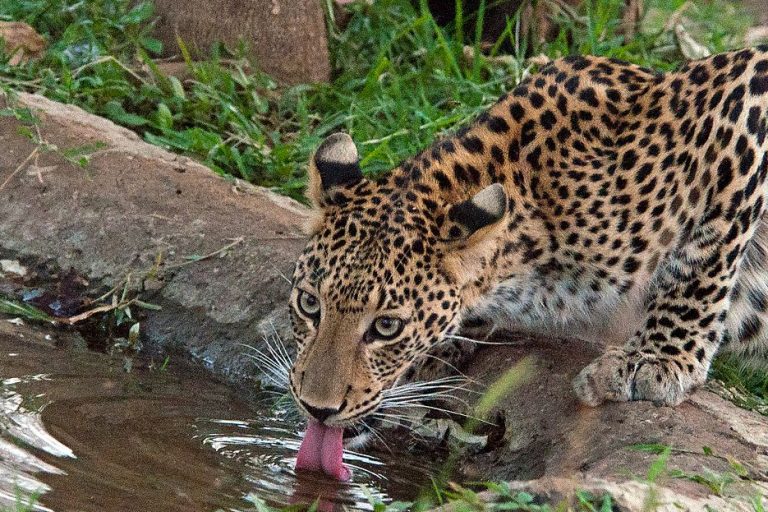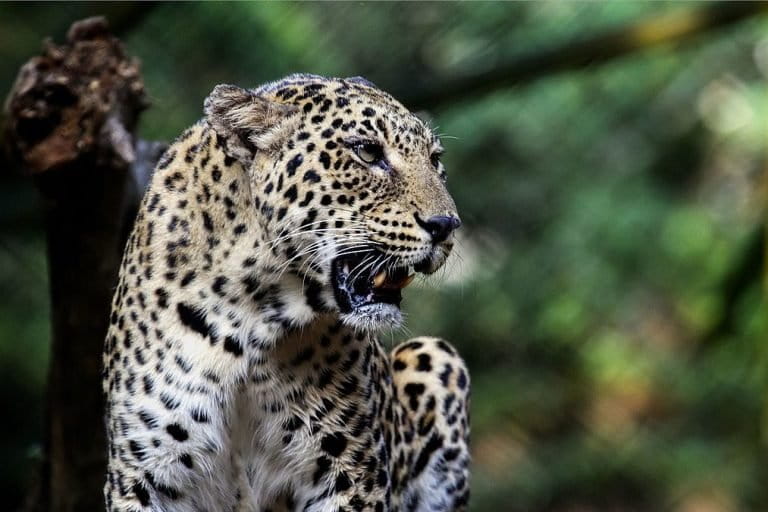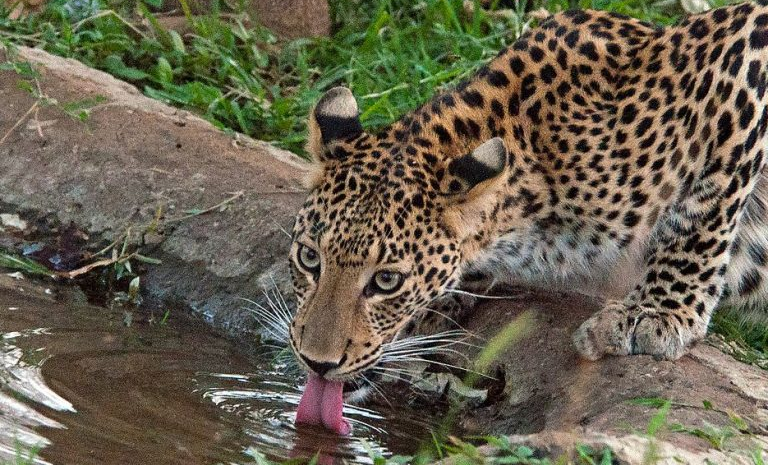- India is all set to establish exclusive leopard parks in Gujarat which will include safaris and rescue centres.
- The leopard is a protected animal under India’s wildlife law but is facing threats of conflict with humans, loss of habitat and poaching.
- Experts feel that conflict resolution and implementing responsible forest management are more the need of the hour.
Aiming to control human-leopard conflict, the government of Gujarat is now developing a “leopard park” which will serve as a rehabilitation centre for leopards rescued from conflict situations. It will include a safari area for generating awareness about these often misunderstood big cats.
The leopard is a protected animal under India’s Wild Life (Protection) Act, 1972, and is among the animals like tigers, lions, and elephants that are accorded highest protection under this law. Even though the leopard is a protected species, it faces a gamut of risks, from poaching and conflict with humans to the loss of habitat.
According to the Wildlife Institute of India (WII), the population of leopards is estimated to be 12,000-14,000 across the country. Gujarat is among the states with a high population of leopards. Data released by the Gujarat government in 2016 claims the population of leopards in the state increased to 1,395 in 2015 from 1,160 in 2011. It is second only to the leopard population in its neighbouring state, Madhya Pradesh, which has the highest number of leopards in India.

The proposal to set up an exclusive leopard park and rescue centre was discussed during the meeting of India’s Ministry of Environment, Forest and Climate Change (MoEFCC) expert forest panel, Forest Advisory Committee (FAC), in March 2018.
What the proposed leopard park will include
The proposal involves a diversion of 50 hectares of forest area for a leopard park and rescue centre at Village Khod Amba in Mandvi region of Surat district in Gujarat. It will include visitors’ facilities like amphitheatre, toilets, safari area including enclosures and other facilities like a veterinary hospital.
As per the proposal, the 50-hectare area will be divided into two parts. The main part, spread across 45 hectares of the total area, will comprise a safari area and a restricted area. The safari area will include chain-linked fencing, three big closed enclosures to house leopards, an open enclosure designed specifically for leopard behaviour and an open safari area with water holes and free-roaming ungulates. The restricted area will include animal houses, cage structures, feeding and water facilities, veterinary hospital, quarantine room and a post-mortem room.
The second part, spread across five hectares, will have visitors’ facilities including a theme based gate, parking, reception, amphitheater, office building, canteen, souvenir shop, toilets and an interpretation center.
According to the minutes of the FAC’s meeting, the committee recommended clearance to the proposal. However, FAC held that the construction activities should be restricted to a minimum and at least 50% of the project area should be maintained as a green area.
The committee also said that “compensatory afforestation shall be raised over double the degraded forest land preferably around the proposed leopard park and rescue centre.” A similar centre is being planned in Surat’s neighbouring Dang district as well.

“The proposed centres at Surat and the other one in Dang are going to be first two exclusive leopard rescue centres/safari parks of the country. It is critical to the region of south Gujarat considering there is a sizeable population of leopards in this region with an average of around 25 leopards per district,” Puneet Nayyar, deputy conservator of forests, Surat told Mongabay-India.
He explained that there are around 200 leopards in the seven to eight districts that fall in the region. He also said that in Surat district alone, large numbers of leopards are rescued every year, predominantly from the non-forest area.
At present, once a leopard is rescued and treated for injuries, it is released back into the wild. But in cases where leopards sustain severe or permanent injuries, they are sent to the zoo. The idea behind the park is to keep such leopards in an area resembling their natural habitat.
“There are high number of cases of human-leopard conflict mainly consisting of the leopard killing cattle. The leopard park will not only help in mitigating human-leopard conflict but also have a positive impact in conservation efforts by bringing people closer to leopards and will lead to their involvement in the welfare of the animals by boosting the local economy of that area through large tourist influx,” Nayyar added.
“It is a good step for rescued cats if such centres are made in a right way. It is because in India, rescued or captured leopards are placed in zoos or animals shelters where sometimes they are literally stacked up in cages or packed to their limits without any enrichment. So, these parks can be a better alternative in terms of a more enriched place for rescued leopards to live in, and for awareness of people, but it all depends on how well they are designed and how well visitors are educated” said Mayukh Chatterjee, who is head of the human-wildlife conflict mitigation division at the Wildlife Trust of India.
“But I don’t know how much people will be tolerant of these big cats when they are in the wild, in sugarcane or paddy fields or in villages,” he added.
Could change in human behaviour be a solution instead?
Similar to the threats faced by other big cats like lions and tigers, leopards in India also face a high risk of being poached for illegal trade in skin and body parts. According to the records of the Wildlife Crime Control Bureau (WCCB) of the MoEFCC, a total of 230 cases of recovery of body parts of leopards were recorded during 2013-2016 (till June 2016). Another study released in 2012 had said that at least four leopards were poached every week during 2001–2010.

However, the ideal way to protect the leopard population and mitigate conflict with humans is still debatable.
Shubhobroto Ghosh, who is the wildlife project manager with the World Animal Protection, India, believes that change in human behaviour and implementing responsible forest management should be the focus instead of creating such centres.
“Any diversion of forest land for keeping animals in captivity, no matter how well-intentioned, is concerning and fraught with problems. Apart from destruction of biodiversity that will inevitably follow as a result of differential land use, there are legitimate worries regarding the fate of the captive leopards because very often, captive carnivores develop behavioural and health problems in captivity,” he said.
“It is better to look into conflict resolution by way of changing human behaviour, land use or grazing patterns and implementing responsible forest management to lessen human-animal conflict to avoid unnecessary human deaths and stressful animal captivity that does not solve problems in the long run,” he emphasised.
Safari parks not new in India
It is not the first time such safari parks are being planned in the country.
India already has safari parks or rescue/rehabilitation centres for animals like tiger, lion and elephants. For instance, there is lion and tiger safari at the Bannerghatta Biological Park in the Bannerghatta National Park near Bangalore (Karnataka), lion and tiger safari at Nandankanan (Odisha), Devalia Safari Park at Gir (Gujarat) and Etawah lion safari (Uttar Pradesh).
Chatterjee explained that the efficiency of such centres depends on how well they are made and maintained.
“Conversely, in such parks, there is a very high chance of disease outbreaks like what happened at Etawah safari where several lions died due to the canine distemper outbreak. Ultimately these are a glorified form of zoos and zoos don’t teach much about the plight of animals, unless they incorporate knowledgeable educators who interact with visitors. These centres can’t be called as rehabilitation centres as rehabilitation is when the wild animals are released back into the wild habitat. But, at such centres, the captive care that an animal gets is much more enriched,” he added.
